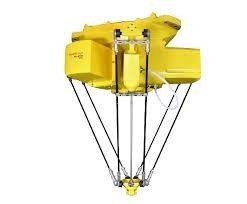“Delta Robots: The Speed Demons of the Industrial World”
INTRODUCTION:
It comes within the category of parallel robots in general as industrial robotics, with spider-like shape Though it was in conception in the 1980s, for the last ten years at least delta robots have been more broadly taken up in manufacturing and other automation industries. This post elaborates on the different uses of their benefits, and most commonly asked questions.
What is a Delta Robot?
A delta robot is a type of parallel manipulator that contains a series of arms attached to a single base. These arms are generally constructed from lightweight materials, such as carbon fiber, for fast motion and accuracy. The most critical feature of the delta robots is the parallelogram arm design, which keeps the end effector orienting but allows for fast translation along all X, Y, and Z axes. It enables delta robots to complete operations at an incredible rate-300 picks per minute has been achieved by certain delta robots47.

Applications of Delta Robots:
Delta robots are applied in many industries due to their speed and efficiency.
Some of the main applications are summarized below:
Pick and Place: Delta robots are mostly used for picking items from conveyor belts and placing them into packaging or assembly lines. Their speed makes them suitable for high-volume production environments13.
Packaging: Delta robots can pack products in boxes or containers with much speed and accuracy in packaging operations. They can be mounted overhead for better access to packaging lines14.
Assembly: Delta robots are suitable for light assembly operations, especially in the electronics industry, where they manipulate small components with high precision36.
Sorting: Equipped with vision systems, delta robots can sort items based on type or size rapidly. This capability improves efficiency in logistics and warehousing15.
Dispensing: They can automate dispensing applications like applying adhesives or other materials during manufacturing processes56.
Advantages of Delta Robots:
Design and functionality of delta robots have several advantages:
High Speed: Delta robots can perform much faster than traditional robotic arms because of their lightweight structure and efficient design5.
Accuracy: The differential arm structure enables high-accuracy movements, hence ideal for activities like electronic component assembly34.
Small Footprint: Overhead positioning saves floor space on the production floors but allows for flexibility in the usage17.
Versatility: Delta robots can easily integrate with advanced technologies like vision systems and force sensors to enhance their functionality7.

Disadvantages of Delta Robots:
Even though delta robots have benefits, there are also certain drawbacks of delta robots that are described below:
Low Payload Capacity: Generally, the payload is lightweight (less than 12 kg) with a lack of capability in heavy-duty applications67.
Limited Working Volume: The integrated structure of the arms limits the working volume compared to other configurations of robots
How Do Delta Robots Work?
The Delta robots look quite different and move fast to get the desired accuracy. They consist of the base, three arms, and the end-effector. The universal joints connecting the arms at the base allow them to move in all directions; the end-effector is normally attached to the end part of the arms to perform an action such as picking on objects or dispensing substances.
Advantages of these products:
The following are the advantages of using a delta robot over other variants:
Speed: Due to this, can really work on tasks that require a lot of speed.
Precision: In terms of precision, delta robots can easily work on tasks that rely much on precision.
Reliability: One of the best points of the delta robot lies in their reliability. End.
Flexibility: Delta robots are suited for highly diverse operations, hence very versatile.
Compact Design: Delta robots have a compact design, easy to install and maintain.
Applications of Delta Robots:
Delta robots find application in a broad spectrum of industries, among them:
Food Industry: Are used for picking and placing food products like fruits and vegetables onto packaging lines. It is also used for packing food products, as well as dispensing food products, which include sauces and dressings.
Electronics Industry: Are used for assembling electronic components, which include printed circuit boards. They also use them for testing electronic components and packaging electronic products.
Pharmaceutical Industry: Are used to pack the pharmaceutical products and also are used for dispensing of pharmaceutical products, such as tablets and liquids.
Automotive Industry: Are used for assembly of automotive components, including automotive parts, like car doors and hoods.

Q:1 What is a delta robot?
A: High speed pick-and-place operations, packaging, assembling light-weight elements, items sorting on the production lines and materials dispensing such as adhesive fall under typical applications.
Q:2 What’s the speed of the delta robot?
A: Delta robots can work at up to 300 picks per minute in operation. It is one of their largest advantages when it comes to working environments for high-volume production.
Q:3 Do delta robots handle heavy payloads?
A: No, are light application machines that can work at normal payloads at 12 kg or lower. They do well dealing with small parts, not with heavy pieces.
Q:3 Do delta robots deal with complex parts?
A: Are best suited for simple geometries due to their speed requirements. Although they can be integrated with vision systems to improve flexibility, handling complex parts is not optimal.
Conclusion:
It represents a new revolution in automation technology with delta robots that would achieve higher speed and precision in the handling of lightweight components across the whole group of industries. Technology will continue to advance further, and the applications will likewise come to new capacities about these .

